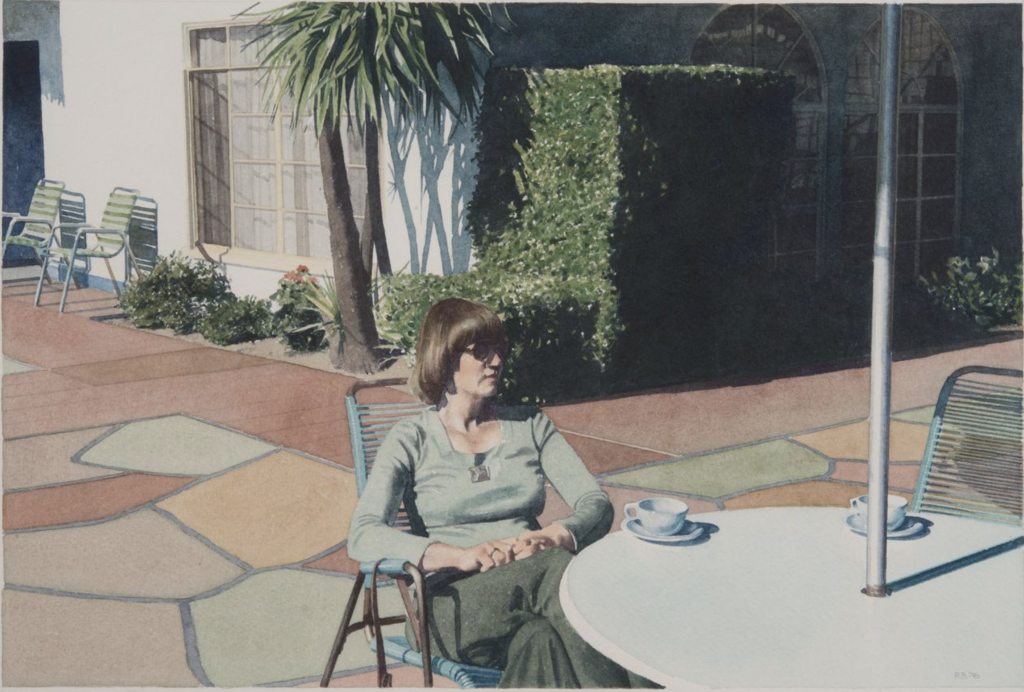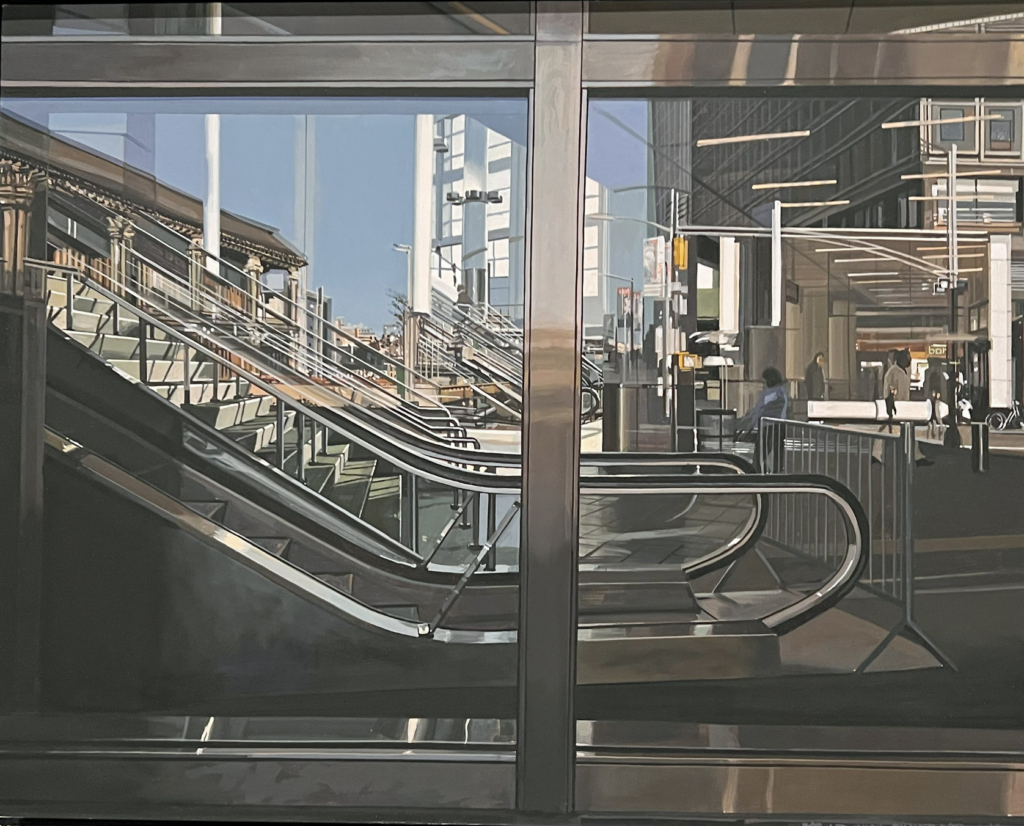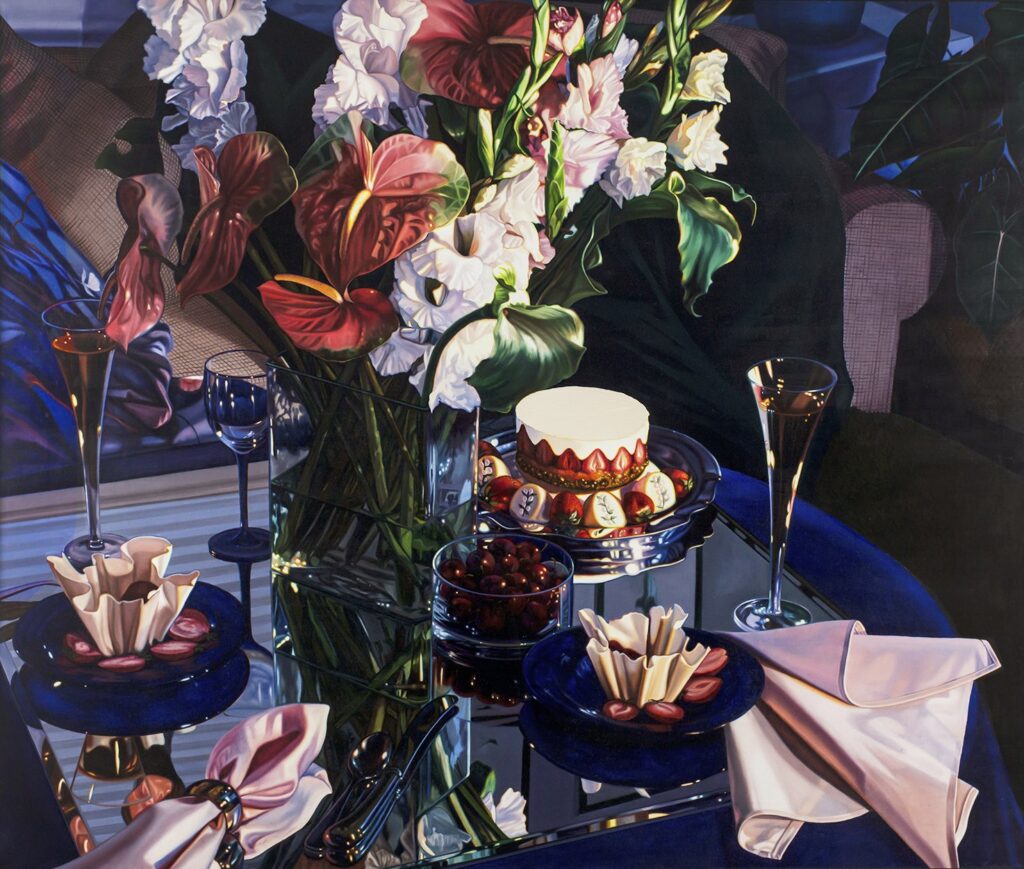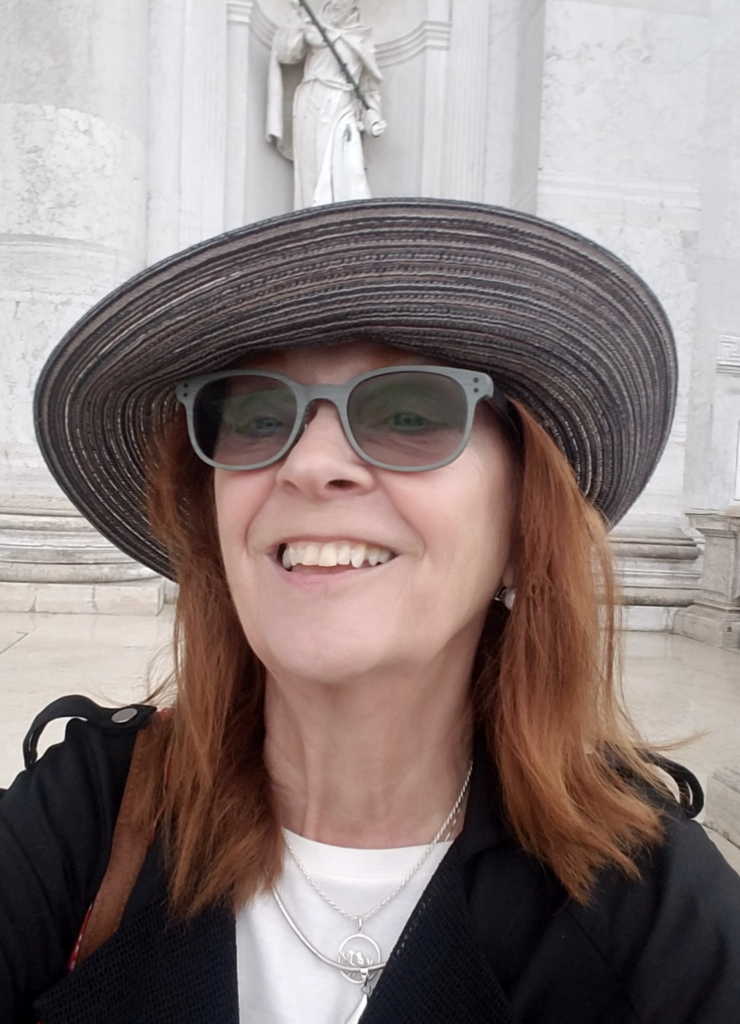Asheville Art Museum “Beyond the Lens: Photorealism and Painting”
Asheville Art Museum “Beyond the Lens: Photorealist Perspectives on Looking, Seeing, and Painting”
Through February 5, 2024.

THE ART. DEALER LOUIS K. MEISEL formulated the word “Photorealism” in 1969 to define artists whose art depended on photographs that typically projected onto the canvas letting the image be simulated with exacting precision and exactness. Oft the artist used an airbrush,that was specifically designed to retouch photographs, so to intensify the accuracy of the picture. The term first appeared in print the following year for the Whitney Museum’s exhibition “Twenty-two Realists.” The Photorealism movement coincided with Conceptual Art, Pop Art and Minimalism. Photorealist artists along with some makers of Pop art reestablished the importance of process, deliberate planning and exacting brushwork over that of extemporization and automatism.
Above, left: Don Jacot, Monkey Business, 2014, oil on canvas, 16×12 ¼”. Collection of Louis K. and Susan Pear Meisel. ©Don Jacot
In the 21st century figurative art has resurfaced with realist painting having a renaissance, as a new generation of artists is ever more drawn to narrative and storytelling. However, Photorealist’ are unlike artists fixated on race, gender and ideology. Absent throughout this exhibition is the edgy tension often found in contemporary work riddled with angst and ugliness. In its place, a tranquil sensibility prevails.
The exhibition Beyond the Lens: Photorealist Perspectives on Looking, Seeing, and Painting was guest curated by Terry Sultan. According to Sultan, “The works presented in Beyond the Lens are artistically diverse and it surveys the evolution of Photorealism, a genre that has continuously pushed the boundaries of perception and representation.”

Right: Robert Bechtle, Ambassador by the Sea, 1976, watercolor on paper, 10×14 ¾”. Collection of Louis K. and Susan Pear Meisel. © Robert Bechtle.
Photorealism is more of a style of realist painting than a movement because the artists worked independently in a variety of media as well as subject matter. Several of the male artists had an acute interest in depicting machinery and objects of industry including trucks, motorcycles and cars as well as urban landscapes. Audrey Flack the most celebrated female Photorealist opted to focus on everyday household items incorporating tubes of lipstick, perfume bottles, Hispanic Madonna’s and fruit as well as images from the horrors of the Holocaust in her paintings. The one connective thread beyond the heightened precise details in the paintings is that the art dealer Louis K. Meisel represented many of the artists.
This presentation comprises noteworthy paintings and works on paper from the collection of Louis K. and Susan Pear Meisel whose gallery in SOHO played a vital role in establishing photorealist painting in the 1970s. Meisel continues today to be the world’s foremost collector and scholar of Photorealism, and his gallery continues to flourish in New York City.
The exhibition contains work by noteworthy artists of the earlier movement including Charles Bell, Robert Bechtle, Tom Blackwell, Richard Estes, Audrey Flack, and Ralph Goings along with pieces by a newer generations of artists Anthony Brunelli, Davis Cone, Bertrand Meniel, Rod Penner, and Raphaella Spence. The subject matter in this show ranges from portraits, cityscapes, cars, trucks, and motorcycles, landscapes, still life, and suburban scenes.
“The paintings in this exhibition do not criticize anything; they are devoid of irony and oft the pictures feels cold and desolate yet they are alluring and striking.”
Ultimately Photorealist painters are concerned with intensified detail and their silent imagery celebrates form, technique, surface and exactness. Commentary about humanity and its foibles is absent. Each composition is as if one is viewing a single instant captured from a sharp high definition television screen. One might think that they are seeing photographs instead of paintings in this display. Pervading throughout the works is commanding photographic precision with numerous subjects being man-made, in complex urban environments. Betrand Meniel,’s multifaceted, panoramic composition Chevy’s, 2018, depicts such embroidered realism. He portrays within the frame multiple events concurrently occurring on a typical busy urban street. What is the message of this painting? Conceivably the fullness and complexity of daily life in the city!

Above: Betrand Meniel, Chevy’s, 2018, acrylic on canvas, 59 × 83 inches. Collection of Louis K. & Susan Pear Meisel. © Betrand Meniel.
Richard Estes photorealist paintings over time have aged well, much as great wine. Each holds information about time past, as well as time present as apparent in several pieces. His work of precise lifelike?details of telephone booths and escalators evince an eccentric invention derived from multiple snapshots of comparable scenes. The final composition is a type of bricolage that is a reinterpretation of a particular place with a heightened level of coexisting components within an ‘a-like’ whole. The configuration “Lee (Corner Window)” (1974) reads like a kaleidoscopic composition capturing the inter play of window refraction and urban detail.

Right: Richard Estes, S.I. Ferry Terminal, 2014, oil on Masonite, 16×20 inches. Collection of Louis K. and Susan Pear Meisel. ©Richard Estes
In “S.I. Ferry Terminal”, 2014, he brings the outside into the interior setting. The Staten Island Ferry was one of his popular subjects –over 12 million passengers annually took on the 5.2-mile sea crossing between the St. George Terminal in Staten Island and the Whitehall Terminal in Lower Manhattan.
Unlike Estes, R.E. Penner, imbues a sense of mystery into his painting “Yellow Light/Brenham, TX”, 2004–2005 through his construction of space and use of light. For the past three decades he has been documenting forgotten landscapes in small Texan towns. The vacant street with foreboding skies evinces a place frozen in time.

Don Jacot focuses on small and inconsequential objects, transporting them into iconic subjects of his work. In “Monkey Business”, 2014 an ordinary old-fashioned metal toy becomes the focus of this painting.
Left: Kim Mendenhall, Cho-Co-Lat, 2000, oil on linen, 53 ½×64 inches. Collection of Louis K. and Susan Pear Meisel. ©Kim Mendenhall
Audrey Flack is distinguished for her paintings of still life’s, dressing tables, cosmetics, food, and flowers. Early on she depicted stereotypes of feminine identities. The image “A Pear to Heade and Heal” 1983, reveals her acute sensitivity to arrangement, color and light. Kim Mendenhall works in a similar genre as Flack. “Cho-Co-Lat”, 2000 is a lush colorful image similarly in the still life genre however her use of chiaroscuro lighting enhances the strong contrasts between light and dark that adds to the drama of this picture.
The paintings in this exhibition do not criticize anything; they are devoid of irony and oft the pictures feels cold and desolate yet they are alluring and striking. One might ask, is Photorealist painting relevant in our digital age? Undeniably taking pictures on the phone and using Instagram is commonplace. More than two billion people around the world are calling, texting, photographing and emailing.
Cellphones have come to occupy ever more a significant role in our lives and social media technology increasingly removes us from the actuality of everyday life. In a fast paced virtual world of technology, looking at Photorealist paintings can slow us down and afford viewers with a window into the everyday world around us filled with an emphasis on meticulous particulars that we haven’t bothered to step into the world and see.

By Elaine A. King, Contributing Editor